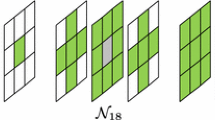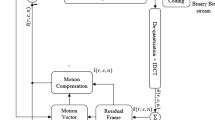Abstract
An ultra-low complexity three-dimensional (3-D) linear-phase infinite-extent impulse response (IIR) velocity filter is proposed for attenuating moving artifacts in videos while enhancing objects moving on smooth approximately-linear trajectories. The proposed 3-D linear-phase IIR velocity filter consists of an ultra-low complexity 3-D wide-angle linear-phase IIR cone filter bank between two two-dimensional (2-D) spatial variable-shift filters. The ultra-low complexity 3-D wide-angle linear-phase IIR cone filter bank consists of a one-dimensional (1-D) temporal modified discrete Fourier transform filter bank and 2-D spatial allpass, IIR highpass and allstop filters. A typical 3-D linear-phase IIR velocity filter of order \(4\times 4\times 510\), applied to enhance a heavily corrupted test video signal, requires only 26 real multiplications and 60 real additions to process a sample and provides a scene-complexity-independent signal-to-interference-and-noise ratio improvement of 13.86 dB. The proposed 3-D linear-phase IIR velocity filter is employed to attenuate sunlight flicker patterns in shallow underwater videos, and experimental results are presented to confirm the effectiveness of the proposed method and its robustness to motion estimation errors.











Similar content being viewed by others
Notes
Original videos are available at http://webee.technion.ac.il/~yoav/research/flicker.html.
References
Anderson, B., & Bruton, L. T. (2002). Non-uniform bandwidth frequency-planar (NUB-FP) filter banks. In Proceedings of IEEE international symposium circuits system, Vol. 1, pp. I–809–I–812.
Antoniou, A. (2006). Digital signal processing: Signals, systems and filters. New York: McGraw-Hill.
Bellanger, M. G., & Daguet, J. L. (1974). TDM-FDM transmultiplexer: Digital polyphase and FFT. IEEE Transactions on Communications, 22(9), 1199–1204.
Blahut, R. E. (2010). Fast algorithms for signal processing. Cambridge: Cambridge University Press.
Bruton, L. T., Bartley, N. R., & Liu, Z. Q. (1995). On the classification of moving objects in image sequences using 3D adaptive recursive tracking filters and neural networks. In Proceedings of 29th Asilomar conference on signals, systems and computers, Vol. 2, pp. 1006–1010.
Bruton, L. T., & Bartley, N. R. (1985). Three-dimensional image processing using the concept of network resonance. IEEE Transactions on Circuits and Systems, 32(7), 664–672.
Bruton, L. T., & Bartley, N. (1986). The enhancement and tracking of moving objects in digital images using adaptive three-dimensional recursive filters. IEEE Transactions on Circuits and Systems, 33, 604–612.
Chang, J. Y., Cheng, C. C., Chien, S. Y., & Chen, L. G. (2006). Relative depth layer extraction for monoscopic video by use of multidimensional filter. In Proceedings of IEEE international conference on multimedia and expo, pp. 221–224.
Crochiere, R. E., & Rabiner, L. R. (1983). Multirate digital signal processing. Englewood Cliffs, NJ: Prentice-Hall.
Dansereau, D. G., & Williams, S. B. (2011). Seabed modeling and distractor extraction for mobile auvs using light field filtering. In Proceedings of IEEE international conference on robotics and automation, pp. 1634–1639.
Dudgeon, D. E., & Mersereau, R. M. (1984). Multidimensional digital signal processing. Englewood Cliffs, NJ: Prentice-Hall.
Duhamel, P., & Hollmann, H. (1984). ‘Split radix’ FFT algorithm. Electronics Letter, 20(1), 14–16.
Edussooriya, C. U. S., Bruton, L. T., & Agathoklis, P. (2011). Under-decimated 3D FIR space-time cone filters using DFT polyphase filter banks for attenuation of radio frequency interference. In Proceedings of IEEE international midwest symposium on circuits and systems, pp. 1–4.
Edussooriya, C. U. S., Bruton, L. T., & Agathoklis, P. (2014a). A low-complexity 3D spatio-temporal FIR filter for enhancing linear trajectory signals. In Proceedings of the IEEE international conference on acoustics, speech and signalprocessing, pp. 1165–1169.
Edussooriya, C. U. S., Bruton, L. T., & Agathoklis, P. (2015a). A 5-D IIR depth-velocity filter for enhancing objects moving on linear-trajectories in light field videos. In Proceedings of IEEE internationalsymposium on circuits and systems, pp. 1–4, accepted.
Edussooriya, C. U. S., Bruton, L. T., Agathoklis, P., & Gunaratne, T. K. (2013). Low-complexity maximally-decimated multirate 3D spatio-temporal FIR cone and frustum filters. IEEE Transactions on Circuits and System I, 60(7), 1845–1856.
Edussooriya, C. U. S., Bruton, L. T., Naeini, M. A., & Agathoklis, P. (2014b). Using 1-D variable fractional-delay filters to reduce the computational complexity of 3-D broadband multibeam beamformers. IEEE Transactions on Circuits and Systems II, 61(4), 279–283.
Edussooriya, C. U. S., Dansereau, D. G., Bruton, L. T., & Agathoklis, P. (2015b). Five-dimensional depth-velocity filtering for enhancing moving objects in light field videos. IEEE Transactions on Signal Processing, 63(8), 2151–2163.
Fliege, N. J. (1993). Computational efficiency of modified DFT polyphase filter banks. In Proceedings of 27th Asilomar conference on signals, systems and computers, Vol. 2, pp. 1296–1300.
Gracias, N., Negahdaripour, S., Neumann, L., Prados, R., & Garcia, R. (2008). A motion compensated filtering approach to remove sunlight flicker in shallow water images. In Proceedings of Oceans, pp. 1–7.
Karp, T., & Fliege, N. J. (1999). Modified DFT filter banks with perfect reconstruction. IEEE Transactions on Circuits and Systems II, 46(11), 1404–1414.
Kennedy, H. L. (2014). Multidimensional digital filters for point-target detection in cluttered infrared scenes. Journal of Electronic Imaging 23(6), 063,019–1–063,019–11.
Kondo, K., & Hamada, N. (2000). Design of optimal filter for detecting linear trajectory signals utilizing object shape and velocity vector. Electronics and Communications in Japan, Part I, 83(2), 42–51.
Kuenzle, B., & Bruton, L. T. (2005). A novel low-complexity spatio-temporal ultra wide-angle polyphase cone filter bank applied to sub-pixel motion discrimination. In Proceedings of IEEE international symposium on circuits and systems, Vol. 3, pp. 2397–2400.
Kuenzle, B., & Bruton, L. T. (2006). 3-D IIR filtering using decimated DFT-polyphase filter bank structures. IEEE Transactions on Circuits and Systems I, 53(2), 394–408.
Lin, Y. P., & Vaidyanathan, P. P. (1994). Application of DFT filter banks and cosine modulated filter banks in filtering. In Proceedings of IEEE Asia-Pacific conference on circuits and systems, pp. 254–259.
Malvar, H. S. (1992). Extended lapped transforms: Properties, applications, and fast algorithms. IEEE Transactions on Signal Process, 40(11), 2703–2714.
Pei, S. C., Kuo, W. Y., & Huang, W. T. (2006). Tracking moving objects in image sequences using 1-D trajectory filter. IEEE Signal Process Letter, 13(1), 13–16.
Schauland, S., Velten, J., & Kummert, A. (2007). Multidimensional linear shift invariant velocity filters for vision-based automotive applications. In Proceedings of international workshop on multidimensional (nD) systems, pp. 83–87.
Schauland, S., Velten, J., & Kummert, A. (2008a). Detection of moving objects in image sequences using 3D velocity filters. International Journal of Applied Mathematics and Computer Science, 18(1), 21–31.
Schauland, S., Velten, J., & Kummert, A. (2008b). Motion-based object detection for automotive applications using multidimensional wave digital filters. In Proceedings of IEEE vehicular technology conference (spring), pp. 2700–2704.
Schechner, Y. Y., & Karpel, N. (2004). Attenuating natural flicker patterns. In Proceedings of MTTS/IEEE Oceans, Vol. 3, pp. 1262–1268.
Schwerdtfeger, T., Velten, J., & Kummert, A. (2014). A multidimensional wave digital filter bank for video-based motion analysis. Multidimensional Systems and Signal Processing, 25(2), 295–311.
Shihavuddin, A., Gracias, N., & García, R. (2012). Online sunflicker removal using dynamic texture prediction. In Proceedings of international joint conference on computer vision, imaging and computer graphics theory and applications (VISAPP), pp. 161–167
Sorensen, H. V., Jones, D. L., Heideman, M. T., & Burrus, C. S. (1987). Real-valued fast Fourier transform algorithms. IEEE Transactions on Acoustics, Speech and Signal Processing, 35(6), 849–863.
Vaidyanathan, P. P. (1993). Multirate systems and filter banks. Upper Saddle River, NJ: Prentice-Hall.
Van Veen, B. D., & Buckley, K. M. (1988). Beamforming: A versatile approach to spatial filtering. IEEE ASSP Magazine, 5(2), 4–24.
Wang, Y., Ostermann, J., & Zhang, Y. Q. (2002). Video processing and communications. Upper Saddle River, NJ: Prentice-Hall.
Acknowledgments
The authors would like to thank the anonymous reviewers for their valuable comments and suggestions, which helped to improve the quality of the paper.
Author information
Authors and Affiliations
Corresponding author
Appendix: Proof of the near-perfect reconstruction of the 3-D wide-angle linear-phase IIR cone filter bank
Appendix: Proof of the near-perfect reconstruction of the 3-D wide-angle linear-phase IIR cone filter bank
The near-perfect reconstruction of the cone filter bank can be proved following an approach similar to that employed in Edussooriya et al. (2013). To this end, the input-output relationship of the cone filter bank is expressed, following (Kuenzle and Bruton 2006; Karp and Fliege 1999), as
where \(\widehat{I}_{in}(z_x,z_y,z_t)\) and \(\widehat{I}_{out}(z_x,z_y,z_t)\), \((z_x,z_y,z_t)\in \mathbb {C}^3\), are the 3-D \(\mathscr {Z}\) transforms of the input signal \(\widehat{i}_{in}(n_x,n_y,n_t)\) and the output signal \(\widehat{i}_{out}(n_x,n_y,n_t)\) of the cone filter bank, respectively, and
The output signal \(\widehat{I}_{out}(z_x,z_y,z_t)\), given in (18), consists of the desired alias-free component \(D(z_x,z_y,z_t)\) corresponding to \(l=0\) and given by
and the undesired aliased component \(A(z_x,z_y,z_t)\) having \((M/2-1)\) aliasing terms corresponding to \(l=1,2,\ldots ,(M/2-1)\) and given by
In order to achieve the perfect reconstruction, the magnitude and the phase responses of the cone filter bank should be unity and linear, respectively, inside the passband. Moreover, the aliased component \(A(z_x,z_y,z_t)\) should be zero inside the passband of the cone filter bank. In what follows, we show that the cone filter bank approximately satisfies the above three conditions and, consequently, achieves the near-perfect reconstruction. To this end, (19) is rewritten, by employing (6), as
Because the prototype filter \(P(z_t)\), designed in Sect. 4.1, has a stopband edge less than \(2\pi /M\) and a fairly high stopband attenuation, it can be shown that (Lin and Vaidyanathan 1994)

By substituting (23) into (22), we can show that
and, therefore, \(||A(z_x,z_y,z_t)||_2\) can be made arbitrarily small in relation to \(||\widehat{I}_{in}(z_x,z_y,z_t)||_2\). In this case, the cone filter bank is almost alias free, and the transfer function \(C(z_x,z_y,z_t)\) can be expressed as
Considering the fact that \(G_k(z_x,z_y)=0\) for all the 2-D spatial allstop filters, (25) can be rewritten as
where \(\mathscr {C}=\{0,1,\ldots ,M_h,M-M_h,M-(M_h+1),\ldots ,M-1\}\). Because \(P(\mathrm {e}^{\,j\omega _t})\approx \sqrt{M}\) and \(G_k(\mathrm {e}^{\,j\omega _x},\mathrm {e}^{\,j\omega _y})\approx 1\), \(k\in \mathscr {C}\), inside their respective passbands, the frequency response of the cone filter bank can be obtained from (26) as
where \(\mathscr {P}\) denotes the region of support corresponding to the passband of the cone filter bank in the 3-D frequency domain. It is clear from (27) that the magnitude response \(\left| C(\mathrm {e}^{\,j\omega _x},\mathrm {e}^{\,j\omega _y},\mathrm {e}^{\,j\omega _t})\right| \) of the cone filter bank is approximately unity inside the passband whereas the phase response \(\angle C(\mathrm {e}^{\,j\omega _x},\mathrm {e}^{\,j\omega _y},\mathrm {e}^{\,j\omega _t})\) of the cone filter bank is approximately linear inside the passband. Therefore, the cone filter bank achieves the near-perfect reconstruction. \(\square \)
Rights and permissions
About this article
Cite this article
Edussooriya, C.U.S., Bruton, L.T. & Agathoklis, P. Velocity filtering for attenuating moving artifacts in videos using an ultra-low complexity 3-D linear-phase IIR filter. Multidim Syst Sign Process 28, 597–616 (2017). https://doi.org/10.1007/s11045-015-0362-3
Received:
Revised:
Accepted:
Published:
Issue Date:
DOI: https://doi.org/10.1007/s11045-015-0362-3




